BRIDGES HALL OF MUSIC—Pomona’s signature building that turns 100 this year—has been a part of my life for half of that span, since I first arrived on campus as a freshman in the fall of 1965.
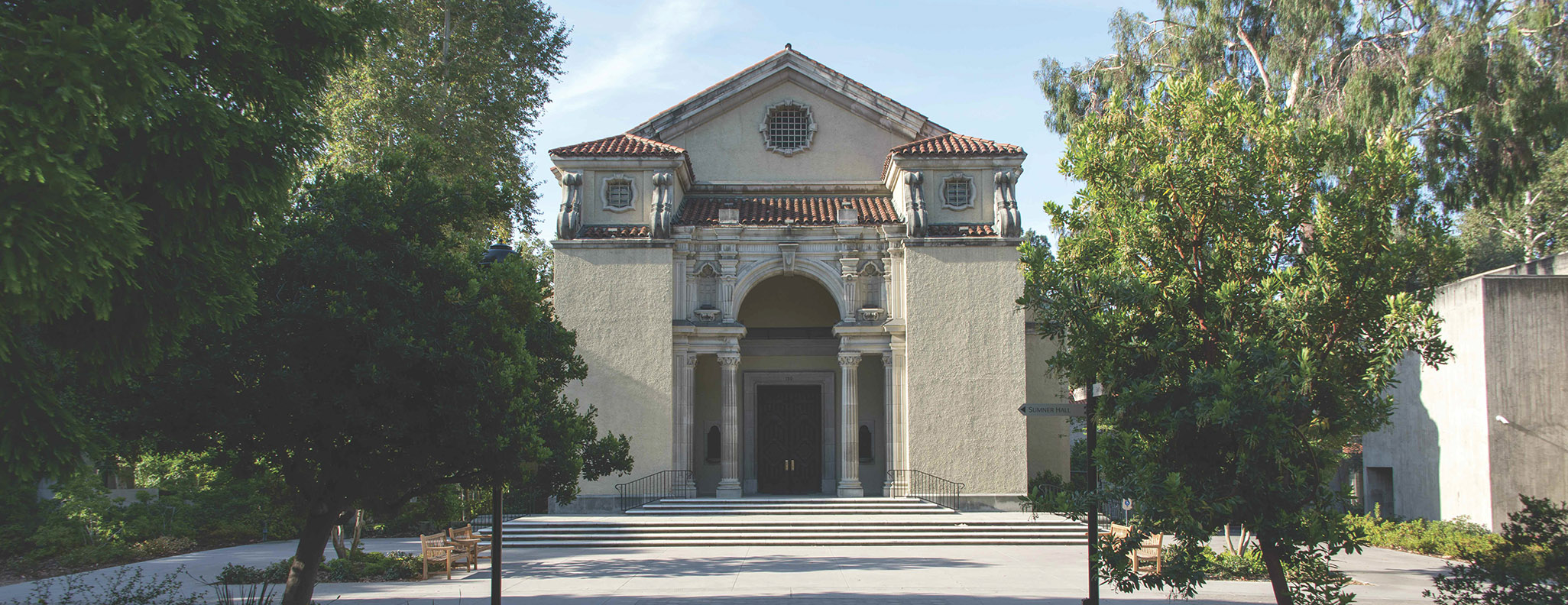
Bridges Hall of Music
In the days before the construction of the Thatcher Music Building, the College Choir rehearsed in the hall daily during the lunch hour; the Band rehearsed on Monday and Wednesday afternoons; the Orchestra and the Men’s and Women’s Glee Clubs rehearsed in the evenings. Large classes were also scheduled there, and I remember taking Professor Karl Kohn’s Music 54 in Bridges during my second semester. The College Church, in whose choir I also sang, met there on Sunday mornings, and I took organ lessons from “Doc” Blanchard on the Moeller Organ. And, of course, all concerts were given there.
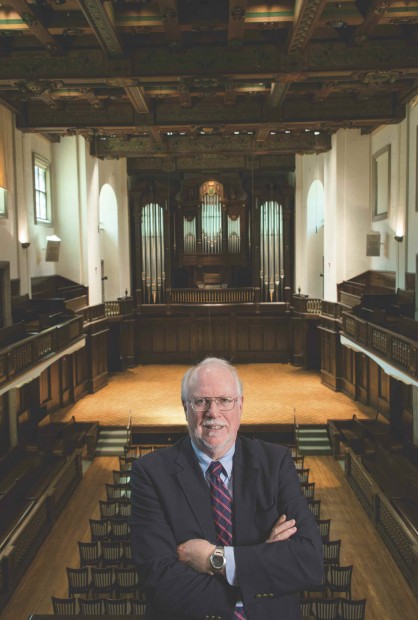
Professor Graydon Beeks ’69 recalls singing with the Choir at the 50th anniversary of Little Bridges in 1966. A member of the music faculty since 1983, Beeks has also served as building manager since 1984.
My freshman year witnessed the celebration of the 50th anniversary of the opening of Little Bridges, which culminated in a performance of Mozart’s Requiem, K626 by the Choir and Orchestra. I did not realize the significance of this celebration at the time, even though there is a note about it in the program. I remember the event mainly as one of the last concerts conducted by Professor Kenneth Fiske, the conductor of the orchestra since 1936, before his retirement the following year.
Over the next four years I attended or participated in innumerable rehearsals, concerts, classes and church services in Little Bridges, but in many ways the most remarkable event was the appearance of “The Web.” This was an intricate assemblage of thin wire strung between the railings of the balcony by a number of students—many of them my classmates—working in secret during the wee hours of the morning and sprung on an unsuspecting public. Professor William F. Russell, the long-serving choir and band director and chair of the Music Department, had an impish sense of humor himself and was pleased with the ingenuity and execution of the project. Since it seemed to improve the acoustics of the hall, it was left in place for some time, until it collected a substantial amount of dust and the wire began to break, at which point it was removed.
Shortly after I graduated in June 1969, a report on the state of College buildings that was prepared for President David Alexander during his first months in office revealed that Bridges Hall of Music did not meet current standards with regard to earthquake safety, and the building was closed. Thought was apparently given to demolition because of the anticipated cost of bringing the building up to code. Fortunately, Trustee Morris Pendleton was able to find the original plans and discovered that the building was built well above code in 1915, reducing the cost of retrofitting by a substantial amount. The funds were raised in 90 days, primarily from loyal alumni, many of whom had been married in the hall; their names are preserved on large panels in the lobby and on small plaques attached to the bench seats.
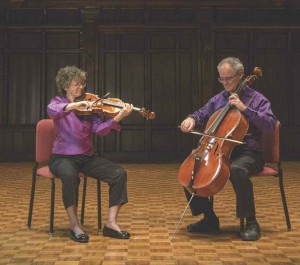
Professor Tom Flaherty (here performing with his wife Cynthia Fogg), has composed dozens of pieces to be performed at Little Bridges, including “Millenium Bridges” a crowd-participation piece written to celebrate the reopening after the 2000–01 renovation.
In addition to seismic retrofitting, acoustical work was done to increase reverberation and prevent the loss of bass frequencies. The stage was enlarged to better accommodate collaborations by the Choir and Orchestra, which had become an annual feature since 1962. A loading dock was added on the west side, eliminating the need to load pianos and other large instruments via a temporary ramp. The hall also gained air conditioning, a new lighting system and new chairs on the main floor.
This was the state of Little Bridges when I returned to Claremont in 1981 and resumed playing in the Band and singing in the Choir. In 1983, I was hired to conduct the Band, and the next year I also took over the supervision of the scheduling and maintenance of the Music Department facilities, including Little Bridges, which I have continued to do until the present.
Many things had changed while I was away. The College Church was no more, and classes were no longer held in Little Bridges. Because of the installation of air conditioning and the threat of vandalism to valuable instruments, the building was no longer left unlocked in the daytime. The Choir and Glee Clubs now rehearsed in Lyman Hall, the smaller auditorium in the new Thatcher Music Building, and the instrumental ensembles, which now included a Jazz Band, rehearsed in Bryant Hall (although the Orchestra and the Concert Band were soon to move back to Little Bridges for evening rehearsals). Most of the student ensembles continued to perform in Little Bridges, and their number was increased in 1993 with the addition of a Javanese Gamelan, using rented instruments, followed in 1995 by the acquisition of the College’s own Balinese Gamelan, “Giri Kusuma” (“Flower Mountain”).
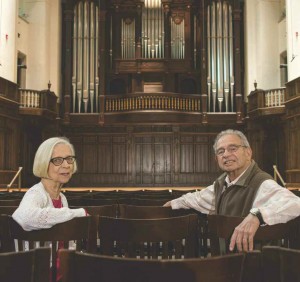
Noted composer and Professor Emeritus Karl Kohn and his wife, Margaret Kohn, came to Pomona in 1950 and gave their first two-piano recital in Little Bridges 65 years ago.
Convocations were now held in Little Bridges rather than Big Bridges, but overall, fewer students had extensive contact with the building, and the number of alumni weddings steadily declined. Finally, most organ practice and performance had moved to the new von Beckerath instrument in Lyman Hall, and despite some reconfiguration in the 1970s and re-leathering in the 1980s, the organ in Little Bridges was beginning to show its age.
There have been many distinguished concerts in Little Bridges in the years since my return to Claremont, but what stands out most clearly in my mind are the concerts related to the celebration of the College’s Centennial in 1987–88. These included performances of newly composed works by Pomona College alumni and a performance by the Pomona College Choir and Orchestra of the Requiem by Maurice Duruflé and of a new work, “To the Young,” commissioned from Pomona alumnus Vladimir Ussachevsky ’35, who had also written the work commissioned to celebrate the College’s 50th anniversary. The Centennial concert was conducted by distinguished alumnus Robert Shaw ’38 and featured Professor Gwendolyn Lytle as soprano soloist.
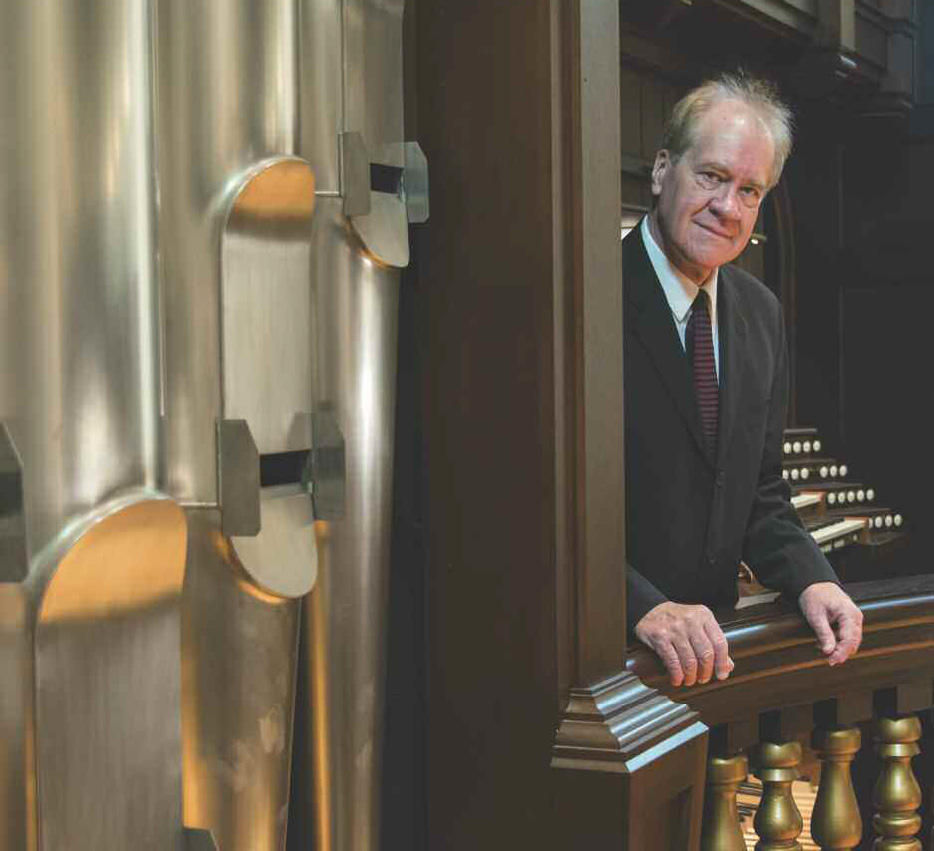
Professor and College Organist William Peterson oversaw the installation of the C.B. Fisk pipe organ, in 2000–01 as part of a full renovation. The instrument has 3,519 pipes ranging from a half-inch to 32 feet long.
I would argue that the single most important event to take place during my 32 years on the Music faculty was the installation of the Hill Memorial Organ, built by C.B. Fisk of Gloucester, Mass., as part of another renovation in 2000–01. This project, spearheaded by College Organist William Peterson, required many years of detailed planning. It involved extensive acoustic alterations, including a quieter air conditioning system and the installation of mass above the ceiling to prevent sound from escaping into the attic (where some enterprising students used to go to listen to concerts). The addition of wings on either side of the building allowed for the installation of an elevator, an accessible restroom and additional storage. The repositioning of air conditioning ducts made it possible to remove some walls added in 1970 and reopen four windows that had been closed off at that time, while the ingenuity of the architect permitted the addition of musician’s galleries above both sides of the stage. Finally, the imaginative design of the new organ case maintains several significant aspects of the original case. All these things, taken together, mean that the current configuration of Little Bridges actually resembles more closely the interior layout of the hall as originally designed by Myron Hunt, while also incorporating the improvements made in 1970 and 2000.
It has been a great privilege for me to work in Little Bridges for what has now been just over half my life. I have appeared on the stage as a conductor, singer, percussionist and harpsichord player. In the course of facilitating appearances by others, I have also made appearances as an announcer, a gaffer, an audio engineer, a lighting technician and a caretaker—jobs that are generally done these days by far more qualified people. In the early years, the light settings would occasionally change of their own accord—sometimes during concerts—and we attributed this to the ghost of Mabel Shaw Bridges 1908. Her ghost has not been as active in recent years, and I hope that is because she is happy about the current state of the hall and the way the College maintains and uses this gift that her parents provided in her memory just over a hundred years ago. I hope to have the opportunity to oversee that legacy for a few more years.
